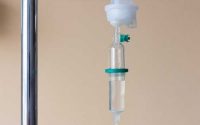COVID-19-Sufferers often die of pulmonary embolism – Naturopathy naturopathy specialist portal
COVID-19-Ill: Increased Rate of thrombosis and pulmonary embolism
COVID-19 results in an unusually high number of cases of disease to thrombosis and pulmonary embolism. This was shown by a study of scientists from Hamburg. The new findings could lead to changes in treatment recommendations for the Coronavirus fell Ill.
A few days ago was published in the journal “Radiology” a scientific investigation of an international research team, of complications due to blood clots in SARS-COV-2 infections have been reported. Researchers have now have detected end from Germany, an increased Rate of thrombosis and pulmonary embolism in individuals with COVID-19-infections.
An unusually high number of cases of disease and led to pulmonary embolism
According to a recent communication from the Institute of legal medicine of the University hospital Hamburg-Eppendorf (UKE) in a large volume of autopsies of patients with COVID-19-infections.
As a result, the research team found out to Prof. Dr. Klaus Püschel, Director of the Institute of legal medicine, and Prof. Dr. Stefan Kluge, Director of the clinic for intensive medicine, that COVID-19 cases, in an unusually high number of disease to thrombosis and lung embolism led.
The results of the study of the first twelve patients were published in the prestigious journal “Annals of Internal Medicine”.
Almost all of the deceased had pre-existing conditions
As it says in the message, can only be reconstructed by the post-mortem of COVID-19-deceased illness history, causes of death ascertained and disease monitoring are recorded in detail.
The previously performed autopsies show that almost all of the deceased’s pre-existing conditions were, for example, the cardiovascular system or the lungs. A to this extent, the perceived sequence of COVID-19 saw the doctors, however, more often: pulmonary embolism and thrombosis.
“We could have had veins in the autopsy of the first 12 deceased to demonstrate that an unexpectedly high Rate of fatal pulmonary embolism stock, in addition, more than half of the patients with thrombosis of the leg,” explains Prof. Dr. Jan Sperhake, a senior physician in the Institute for legal medicine and first author of the study.
Clinically this was already suspected by the researchers, now at the autopsy of the first twelve patients, scientifically proven, and in the further course, in the meantime, a total of 192 medical examinations confirmed.
The SARS-CoV-2 Virus does not appear to result in the veins to the formation of blood clots, which, as a so-called pulmonary emboli in the large pulmonary vessels and lead to acute circulatory failure.
Affected may need to receive Blood thinners
What are the factors that are actually responsible for the COVID-19-patients, form more often a blood clot, however, is not clarified yet.
However, the studies provide indications to improve the treatment of COVID-19-Sick.
“We are thinking about whether these patients should be treated according to individual risk assessment, primarily with a Blood thinner to prevent future thrombosis and pulmonary embolism,” said Priv.-Doz. Dr. Dominic Wichmann, a senior physician in the clinic for intensive care medicine and first author of the study.
“A prerequisite for further study are results. In order to prove a Benefit to the patient really needed a larger randomized trial.“
Autopsies of COVID-19-deceased
According to the communication, the careful examination of the dead since the 23. March, and proved that it was the majority of the deceased was previously physically or immunologically significantly affected patients.
Many of the Affected meadows pre-existing conditions of heart, lungs, and kidneys as well as metabolic diseases (e.g. Diabetes mellitus), cancer, or dementia. Deaths have always been a pneumonia with or without pulmonary embolism. Meanwhile, some of the virus were, however, positive deaths with COVID-19-independent cause of death.
According to the age and gender distribution of the in the Institute for legal medicine 192 of the deceased examined so far, a ratio of about 44 percent women and 56 percent men. The average age of the deceased is, therefore, at 80 years (range 31-99 years); in men 77 years, women 82 years. (ad)


